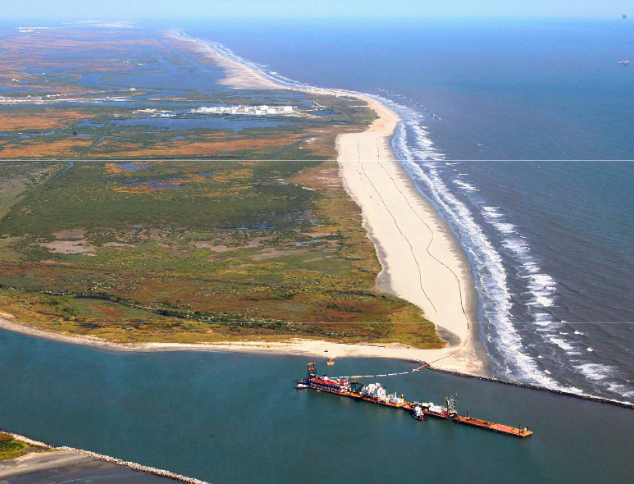Where’s the safety factor in silver and gold?
February 18, 2015
Kennedy blasts Jindal’s ‘accounting gimmicks’
February 18, 2015As the Coastal Protection and Restoration Authority changes its leadership, both the old and new chairmen expressed excitement in continuing the fight to save Louisiana’s wetlands at last Tuesday’s South Central Industrial Association monthly luncheon.
Former CPRA chairman Jerome “Zee” Zeringue, who resigned in late January, and the man who Gov. Bobby Jindal appointed to replace him, Chip Kline, discussed the coastal restoration projects that lie ahead and the issues that stand before them.
Discussing programs from the CPRA’s 2012 Master Plan – a comprehensive look, encompassing science and technology at advancing concepts and projects, matched with a 2007 Master Plan, which was more conceptual and laid the groundwork for what was ahead, both have resulted in more than 159 miles of levees being constructed or approved and close to 20,000 acres of wetlands being built or repaired since 2008 in Louisiana.
“Building wetlands is not rocket science. We’ve been building wetlands for decades. The key to the goal is to build wetlands that are sustainable for generations to come, and we have been successful,” said Zeringue, who served as chairman for roughly a year.
Zeringue, however, warned local business and political leaders of President Barack Obama’s recently released 2016 budget which planned to do away with the Gulf of Mexico Security Act (GOMESA), a law which requires the federal government to dole out 37.5 percent of the money it collects from offshore oil and gas rigs in the Gulf of Mexico to Louisiana, Mississippi, Alabama and Texas.
“We do believe and feel that if we can get the funding, and the president doesn’t screw it up, the additional funding that we have from GOMESA, and other efforts, that we can achieve the land building goal and achieve a sustainable ecosystem for generations to come,” Zeringue said.
With the program set to fully kick in two years from now and provide Louisiana with between $400 and $700 million per year, Kline said it is a revenue stream CPRA has been anticipating for a long time.
“This is a revenue stream that we have planned our efforts around, and I can tell you that we’re going to work very closely with our congressional delegation to make sure that this doesn’t happen. I’m pretty sure that there’s a former chairman (of the Coastal Protection and Restoration Authority),” Kline said, referring to recently elected U.S. Rep. Garret Graves, “that’s chomping at the bit to have this discussion up in Washington, but it’s something that we’re keeping a very close eye on.”
As for the past seven years, CPRA has implemented more than 2.1 billion in restoration projects and 11.2 billion in hurricane protection projects since 2008, including 1.7 billion in Terrebonne, Lafourche and St. Mary parishes. Of that $1.7 billion, 41 percent is in projects that are currently in engineering and design, 18 percent is in the Operations, Maintenance and Management stage, 17 percent is in construction, 10 percent is headed to bid and 1 percent is in the planning stage.
Currently under construction in the Bayou Region is the $217 million Caminada increment 1 and 2 projects, a $137 million Morganza to the Gulf project and a $2.7 million Franklin floodgate, barge and pump station project.
“We remain 100 percent committed to the Morganza to the Gulf project. We’re going to get this project built,” Kline said.
Currently heading to bid is a $26 million Barataria Basin Landbridge project, a $20 million Mississippi River Reintroduction into Bayou Lafourche project, a $35 million Lost Lake Marsh Creation project and a $111 million North Caillou Lake Headlands project.
Kline said the Mississippi River Reintroduction into Bayou Lafourche project will be funded by Coastal Impact Assistance Program funds and aims to bring the capacity of Bayou Lafourche to a 1,000 cubic feet per second channel for an additional seven to 12 miles.
“This will benefit the Terrebonne barataria basin in reduction of salinities and nourishment of the wetlands with introduction and distribution of sediment and nutrients from the river,” Kline said.
Currently in the Engineering and Design phase is the $358 million Houma Navigation Canal Lock project, which will reduce saltwater intrusion to the fresh water in the Terrebonne basin, while also providing storm surge protection as part of the Morganza to the Gulf System. It is being funded by 2009 surplus and RESTORE Act dollars. The phase is expected to be completed within two years.
Also currently in the Engineering and Design phase in the Bayou Region is a $148 million East Timbalier Island Restoration project, a $39 million Island Road Marsh Creation project, a $30 million North Catfish Lake Marsh Creation project and a $28 million Terrebonne Bay Marsh Creation project.
Kline said that many other projects which aren’t part of the Master Plan are worthy of consideration for funding, so as part of what the state will receive in RESTORE Act dollars, 10 percent would be offered to partner with local sponsors and parishes in order to help get them off the ground.
“Over the last seven years, we have made more progress in restoring and protecting our coast than any other time in the history of our state, and I can commit to you that over the next year we’re going to maintain the sense of urgency that we always have,” Kline said to local business and political leaders. “We’re going to remain focused on our mission. We’re going to continue the progress that we’ve made, and we’re going to continue to build upon the success that we’ve had.”
—
A previous version of this story reported that Louisiana is slated to receive $400 to $700 from GOMESA in 2017.
The state is slated to receive $400 to $700 million.
The Times apologizes for the error.
A 2-phase, combined $217 million Caminada headlands project is among many projects in the Coastal Protection and Restoration Authority’s Master Plan.











